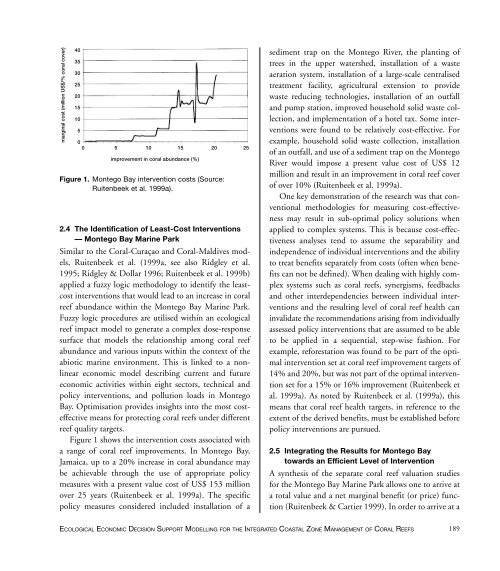You also want an ePaper? Increase the reach of your titles
YUMPU automatically turns print PDFs into web optimized ePapers that Google loves.
marginal cost (million US$/% coral cover)<br />
40<br />
35<br />
30<br />
25<br />
20<br />
15<br />
10<br />
5<br />
0<br />
0 5 10 15 20 25<br />
improvement in coral abundance (%)<br />
Figure 1. Montego Bay intervention costs (Source:<br />
Ruitenbeek et al. 1999a).<br />
2.4 The Identification <strong>of</strong> Least-Cost Interventions<br />
— Montego Bay Marine Park<br />
Similar to the <strong>Coral</strong>-Curaçao and <strong>Coral</strong>-Maldives models,<br />
Ruitenbeek et al. (1999a, see also Ridgley et al.<br />
1995; Ridgley & Dollar 1996; Ruitenbeek et al. 1999b)<br />
applied a fuzzy logic methodology to identify the leastcost<br />
interventions that would lead to an increase in coral<br />
reef abundance within the Montego Bay Marine Park.<br />
Fuzzy logic procedures are utilised within an ecological<br />
reef impact model to generate a complex dose-response<br />
surface that models the relationship among coral reef<br />
abundance and various inputs within the context <strong>of</strong> the<br />
abiotic marine environment. This is linked to a nonlinear<br />
economic model describing current and future<br />
economic activities within eight sectors, technical and<br />
policy interventions, and pollution loads in Montego<br />
Bay. Optimisation provides insights into the most costeffective<br />
means for protecting coral reefs under different<br />
reef quality targets.<br />
Figure 1 shows the intervention costs associated with<br />
a range <strong>of</strong> coral reef improvements. In Montego Bay,<br />
Jamaica, up to a 20% increase in coral abundance may<br />
be achievable through the use <strong>of</strong> appropriate policy<br />
measures with a present value cost <strong>of</strong> US$ 153 million<br />
over 25 years (Ruitenbeek et al. 1999a). The specific<br />
policy measures considered included installation <strong>of</strong> a<br />
sediment trap on the Montego River, the planting <strong>of</strong><br />
trees in the upper watershed, installation <strong>of</strong> a waste<br />
aeration system, installation <strong>of</strong> a large-scale centralised<br />
treatment facility, agricultural extension to provide<br />
waste reducing technologies, installation <strong>of</strong> an outfall<br />
and pump station, improved household solid waste collection,<br />
and implementation <strong>of</strong> a hotel tax. Some interventions<br />
were found to be relatively cost-effective. For<br />
example, household solid waste collection, installation<br />
<strong>of</strong> an outfall, and use <strong>of</strong> a sediment trap on the Montego<br />
River would impose a present value cost <strong>of</strong> US$ 12<br />
million and result in an improvement in coral reef cover<br />
<strong>of</strong> over 10% (Ruitenbeek et al. 1999a).<br />
One key demonstration <strong>of</strong> the research was that conventional<br />
methodologies for measuring cost-effectiveness<br />
may result in sub-optimal policy solutions when<br />
applied to complex systems. This is because cost-effectiveness<br />
analyses tend to assume the separability and<br />
independence <strong>of</strong> individual interventions and the ability<br />
to treat benefits separately from costs (<strong>of</strong>ten when benefits<br />
can not be defined). When dealing with highly complex<br />
systems such as coral reefs, synergisms, feedbacks<br />
and other interdependencies between individual interventions<br />
and the resulting level <strong>of</strong> coral reef health can<br />
invalidate the recommendations arising from individually<br />
assessed policy interventions that are assumed to be able<br />
to be applied in a sequential, step-wise fashion. For<br />
example, reforestation was found to be part <strong>of</strong> the optimal<br />
intervention set at coral reef improvement targets <strong>of</strong><br />
14% and 20%, but was not part <strong>of</strong> the optimal intervention<br />
set for a 15% or 16% improvement (Ruitenbeek et<br />
al. 1999a). As noted by Ruitenbeek et al. (1999a), this<br />
means that coral reef health targets, in reference to the<br />
extent <strong>of</strong> the derived benefits, must be established before<br />
policy interventions are pursued.<br />
2.5 Integrating the Results for Montego Bay<br />
towards an Efficient Level <strong>of</strong> Intervention<br />
A synthesis <strong>of</strong> the separate coral reef valuation studies<br />
for the Montego Bay Marine Park allows one to arrive at<br />
a total value and a net marginal benefit (or price) function<br />
(Ruitenbeek & Cartier 1999). In order to arrive at a<br />
ECOLOGICAL ECONOMIC DECISION SUPPORT MODELLING FOR THE INTEGRATED COASTAL ZONE MANAGEMENT OF CORAL REEFS<br />
189


















